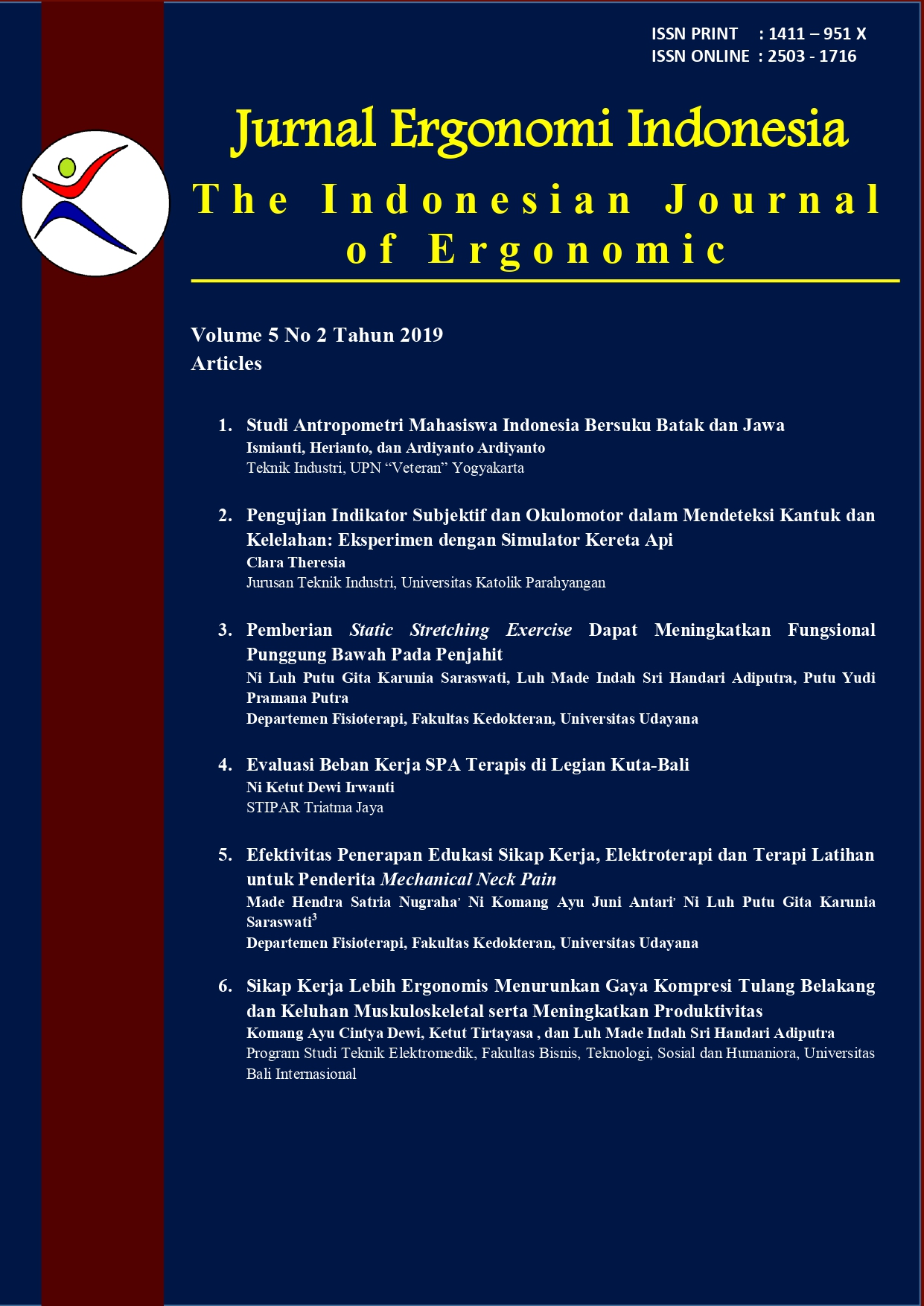Studi Antropometri Mahasiswa Indonesia Bersuku Batak Dan Jawa
Abstract
Perbedaan suku bangsa merupakan salah satu faktor yang berpengaruh terhadap variasi antropometri. Walaupun Indonesia terdiri dari berbagai suku bangsa, penelitian antropometri yang membahas hal tersebut masih sangat terbatas. Penelitian ini dilakukan untuk mengumpulkan data antropometri mahasiswa Indonesia, sekaligus membandingkan dimensi antropometri antara mahasiswa Indonesia bersuku Batak dan Jawa. Pengukuran 58 dimensi antropometri dilakukan pada 286 mahasiswa laki-laki dan 210 mahasiswa perempuan. Hasil pengukuran disajikan dalam statistik deskriptif dalam rerata, simpang baku, dan nilai persentil. Selain itu, perbandingan antropometri antar jenis kelamin dan suku dilakukan dengan uji t dan uji Mann-Whitney. Hasil perbandingan pada peserta perempuan dan laki-laki untuk masing-masing suku menunjukkan perbedaan yang signifikan hampir di seluruh dimensi, di mana peserta laki-laki cenderung memiliki dimensi yang lebih besar daripada perempuan (p<0,05). Perbandingan antropometri antar suku pada peserta laki-laki menunjukkan bahwa terdapat perbedaan signifikan pada 13 dimensi dengan kecenderungan laki-laki bersuku Jawa memiliki dimensi kaki yang lebih besar, sedangkan peserta laki-laki bersuku Batak memiliki dimensi lebar seperti lebar mulut dan lebar kaki yang lebih besar. Pada peserta perempuan, terdapat perbedaan yang signifikan pada 27 dimensi di mana terdapat kecenderungan peserta bersuku Batak memiliki dimensi posisi duduk menghadap belakang yang lebih besar, sedangkan peserta bersuku Jawa cenderung memiliki dimensi tangan yang lebih besar
Downloads
References
Chuan, T. K., Hartono, M., Kumar, N. 2010. Anthropometry of the Singaporean and Indonesian populations. International Journal of Industrial Ergonomics, Vol. 40:757-766.
Heald, F. P. 1969. Nutrition (Introduction) In FP Heald (ed) : Adolescent Nutrition and Growth. New York: Meredith Corporation
Hu, H., Li, Z., Yan, J., Wang, X., Xiao, H., Duan, J., Zheng, L. 2007. Anthropometric measurement of the Chinese elderly living in the Beijing area. International Journal of Industrial Ergonomics, Vol. 37:303 -311.
Iseri, A., Arslan, N. 2009. Estimated anthropometric measurements of Turkish adults
and effects of age and geographical regions. Int. J. Ind. Ergon, Vol. 39:860-865.
Klamkay, J., Sungkhapong, A., Yodpijit, N., Patterson, P.E. 2008. Anthropometry of Southern Thai populations. International Journal of Industrial Ergonomics, Vol. 38:111-118.
Lee Y. C., Chen C. H., Khoo L. P. 2018. A Pilot Study of Gender Differences on Anthropometric Measurements in Singapore Population. AHFE 2017 Advances in Intelligent Systems and Computing, Vol 602. Springer, pp 42-51
Malla, K., Mall, T., Rao, S., Gauchan, E., Basnet, S., Koirala, D. P. 2012. Antropometric Measurements in Diff erent Ethnic groups of Nepalese New Borns, J Nepal Paediatr Soc, Vol. 32(1):1-8.
Mandahawi, N., Imrhan, S., Al-Shobaki, S., dan Sarder, B. 2008. Hand anthropometry survey for the Jordanian population. International Journal of Industrial Ergonomics, Vol. 38(11-12):966-976.
Mehrparvar, A. H., Mirmohammadi, S. J., Hafezi, R., Mostaghaci, M., dan Davari, M. H. 2015. Static anthropometric dimensions in a population of Iranian high school students: considering ethnic differences. Human factors, Vol. 57(3):447-460.
Nidiaputri, A. E., dan Ardiyanto, A. 2017. Hand Anthropometry of Indonesian Young Adult Females. Jurnal Ergonomi dan K3, Vol. 2(1):19-26.
Nurmianto, E. 1996. Ergonomi : Konsep Dasar dan Aplikasinya. Jakarta: PT Guna Widya.
Perwira, S. M. 2001. International and Internal Migration in Indonesia, Paper prepared for “AD Hoc Expert Group Meeting in the Theme “Migration and Development Opportunities and Challenges for Poverty Reduction in Escape Region”
Pheasant, S., Haslegrave, C. M. 2006. Body Space : Anthropometry, Ergonomics, and the Design of Work, 3rd edition. Taylor dan Francis
Sirajuddin, S. M., Duggirala, R., Crawford, M. H. 1994. Population structure of the
Chenchu and other south Indian tribal groups: relationships between genetic,
anthropometric, dermatoglyphic, geographic, and linguistic distances. Hum.
Biol.: Int. Rec. Res., Vol. 66:865-884.
Wickens, C. D., Lee, J. D., Liu, Y., Becker, S. E. G. 2004. An Introduction to Human Factors Engineering, 2nd ed., New Jersey: Prentice Hall.
Widyanti, A., Susanti, L., Sutalaksana, I. Z., Muslim, K. 2015. Ethnic differences in Indonesian anthropomtery data : Evidence from three different largest ethnics, International Journal of Industrial Ergonomics, Vol. 47:72-78.

















